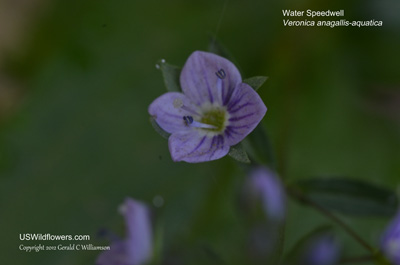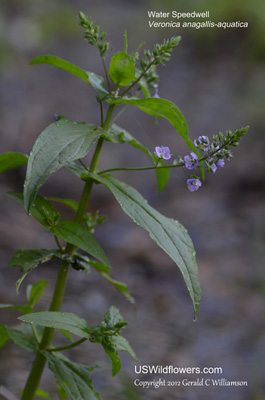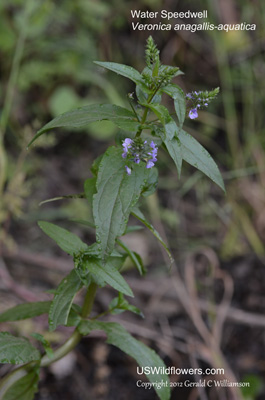Wildflowers of the United States | |||||||||||||
| |||||||||||||
Veronica anagallis-aquatica - Water Speedwell, Sessile Water-speedwell, Brook-pimpernell, Blue Water Speedwell. This is a widely distributed Speedwell, being recorded in all but 5 states. It is also found in most of Canada. It is protected as Endangered or Threatened in Indiana, Massachusetts, New Jersey, and Tennessee.
| There is some disagreement as to whether or not V. anagallis-aquatica is native to North America - USDA Plants Database lists it as native in the lower 48 and Canada, but introduced in Alaska. Calflora lists it as introduced in California and widely so in North America - native to Europe. USDA GRIN lists it as native to Europe, Asia, and South America, but not to North America. Flora of Missouri lists it as Introduced. In addition to native status, the classification of plants included in this genus is debated. There are about 15 synonyms of Veronica anagallis-aquatica. Some experts, including the USDA Plants Database, consider Veronica catenata to be a separate species, while others consider it to be part of Veronica anagallis-aquatica. Veronica catenata is widely considered a native species, and my guess is that is why some also consider V. anagallis-aquatica to be a native plant. Those that consider V. catenata to be a separate species likely classify V. anagallis-aquatica as Introduced. However, some authorities question the native status of V. catenata as well (USDA Germplasm Resources Information Network). I am listing this plant as Introduced, but the USDA map shown on this site will show it as Native to the lower 48. The Endangered status in three states is based on inclusion of V. catenata within V. anagallis-aquatica. Found in: AK, AL, AR, AZ, CA, CO, CT, DE, FL, GA, IA, ID, IL, IN, KS, KY, MA, MD, ME, MI, MN, MO, MT, NC, ND, NE, NJ, NM, NV, NY, OH, OK, OR, PA, RI, SD, TN, TX, UT, VA, VT, WA, WI, WV, WY   Blue=Native; Grey=Introduced Map from USDA Plants Database: USDA, NRCS. 2017. The PLANTS Database (http://plants.usda.gov, 03 Apr 2025). National Plant Data Team, Greensboro, NC 27401-4901 USA. Search Our Database: Enter any portion of the Scientific, Common Name, or both. Do a general Google search of the entire site: #ad
| #ad
| | ||||||||||
|
Commercial / Cookie Notice Looking for Wildflowers for a specific state? Check here: | |||||||||||||
|
| |||||||||||||




